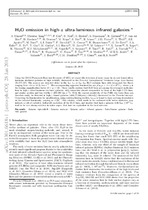| dc.contributor.author | Omont, A. | |
| dc.contributor.author | Yang, Chentao | |
| dc.contributor.author | Cox, P. | |
| dc.contributor.author | Jarvis, Matt | |
| dc.date.accessioned | 2018-02-16T08:03:09Z | |
| dc.date.available | 2018-02-16T08:03:09Z | |
| dc.date.issued | 2013 | |
| dc.identifier.citation | Omont, A. et al. (2013). H2O emission in high-z ultra-luminous infrared galaxies. Astronomy & Astrophysics, 530: A115 | en_US |
| dc.identifier.issn | 0004-6361 | |
| dc.identifier.uri | http://dx.doi.org/10.1051/0004-6361/201220811 | |
| dc.identifier.uri | http://hdl.handle.net/10566/3502 | |
| dc.description.abstract | Using the IRAM Plateau de Bure interferometer (PdBI), we report the detection of water vapor in six new lensed ultraluminous
starburst galaxies at high redshift, discovered in the Herschel Astrophysical Terahertz Large Area Survey (H-ATLAS). The sources are detected either in the 202–111 or 211–202 H2O emission lines with integrated line fluxes ranging from 1.8 to 14 Jy km s−1. The corresponding apparent luminosities are μLH2O _ 3 − 12 x 108 L⊙, where μ is the lensing magnification factor (3 < μ < 12). These results confirm that H2O lines are among the strongest molecular lines in high-z ultra-luminous starburst galaxies, with intensities almost comparable to those of the high-J CO lines, and similar profiles and line widths (_200-900 km s−1). With the current sensitivity of the PdBI, the water lines can
therefore easily be detected in high-z lensed galaxies (with F(500μm)>100mJy) discovered in the Herschel surveys.
Correcting the luminosities for amplification, using existing lensing models, LH2O is found to have a strong dependence
on the infrared luminosity, varying as _L1.2 IR . This relation, which needs to be confirmed with better statistics, may
indicate a role of radiative (infrared) excitation of the H2O lines, and implies that high-z galaxies with LIR &1013 L⊙
tend to be very strong emitters in water vapor, that have no equivalent in the local universe. | en_US |
| dc.language.iso | en | en_US |
| dc.publisher | edp sciences | en_US |
| dc.rights | This is the pre-print version (From arXiv:1301.6618) of the article published online at: http://dx.doi.org/10.1051/0004-6361/201220811 | |
| dc.subject | Galaxies | en_US |
| dc.subject | High-redshift | en_US |
| dc.subject | Starburst | en_US |
| dc.subject | Infrared | en_US |
| dc.subject | Submillimeter | en_US |
| dc.subject | Radio lines | en_US |
| dc.title | H2O emission in high-z ultra-luminous infrared galaxies | en_US |
| dc.type | Article | en_US |
| dc.privacy.showsubmitter | FALSE | |
| dc.status.ispeerreviewed | TRUE | |
| dc.description.accreditation | Web of Science | |

